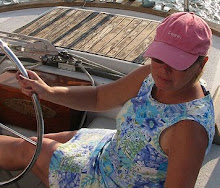I did not know this going in, but visiting the Dry
Tortugas has been on Gary's bucket list since he was a kid. As the story goes, he saw a photograph of
Fort Jefferson and was completely entranced by it and knew that he wanted to
visit there some day.
The harbor was important back in the day and is
important now as it is a wonderful deep anchorage for ships of almost any
size. When we came in, there were
fishing boats, larger yachts, and some other sailing vessels.
The first morning there, we noticed thousands of
birds on Bush Key (adjoining Garden Key).
We found out they are nesting terns; the momma lays her egg in a shallow
sand nest and then shades it from the harsh sun while the males spend most of
their day flying overhead warding off any predators, such as the frigate birds,
who love to dine on newborn terns.
Frigates are large birds with a huge windspan and are threatening just
in appearance. The terns have their work
cut out for them. The noise was a little
overwhelming at first, but like most things, we got used to it right away.
We also noticed a rather large dark scary object
floating under our boat (and no, it wasn't our shadow!). It was a big, big fish! We found out later that Goliath Grouper are
common in the harbor. One day, we had
three at one time, one large dark one, and two others who were more tan mottled
looking. In all, four different groupers
visited the boat. The guys actually got
in the water with them and got some photos; Gary had to work on the zinc and
our impeller had clogged with seagrass, so that's the only good way to swim
with the fishes!
A loggerhead turtle also visited the anchorage,
surfacing with a big "pah" and seemed to be headed over to Bush Key
to hang out with the terns and frigate birds.
Fort Jefferson is on Garden Key, one of the islands
of the Dry Tortugas. That name
originally was Las Tortugas (The Turtles), but was changed to Dry Tortugas on
maps to show that fresh water was not to be had here. The fort was began in 1846 as a watery
stronghold to control navigation to the Gulf of Mexico and protect trade
emanating from the Mississippi River.
The fort, even after being worked on for 30 years, was never
completed. It never really was a fort,
either, because during the Civil War, it acted as a Union Military prison and
also had the distinction of holding four men who were supposedly involved in
Abraham Lincoln's assassination. One of
these folks were Dr. Mudd, who showed admirable empathy by using his medical
skills to help sick people at the fort even though he was imprisoned there.
There is more history of the fort and I'd recommend reading
a bit on it. We also got a novel written
by Nevada Barr called Flashback (An Anna Pigeon Novel), which takes place on
the island and surrounding islands. It
is good reading and she also throws in some history (some embellished) to make
it more interesting.
From the harbor, you can see the main entrance of
the fort. This is where you check in and
where, each day around 10am, a boat full of visitors from Key West arrives to
sun and snorkel and tour the fort. We
thought, oh well, there goes the neighborhood, but it really never felt
crowded. The fort, which was never
finished because it started sinking from the weight of the 16 million bricks
used to construct it, is still losing pieces here and there.
Gary helped a neighboring visitor to shore one day
to get some traveling papers sent (we think they're off to Cuba) and while Gary
was talking to one of the rangers, a sharp flint of brick fell from the
ceiling. The ranger seemed nonchalant
and said, yes, that does happen from time to time. Don't tell anyone, but we kept the shard as a
souvenir.
Of course, there is a moat, and this moat is extra
special because it has its very own American Crocodile. His name is Carlos. He is of Everglades and Jamaican
extraction. We didn't know if we'd be
able to see it, but one day, after the tour boat unloaded its passengers, here
comes Carlos swimming up close to the bridge.
He stopped, looked at all the people, and just sat there for about five
minutes, long enough for everyone to get a best angle shot of this
not-camera-shy croc. Then he swam on and
lay in the grass further along the moat.
He arrived on his own volition in 2003 and seems to
have found his permanent home. The moat
does not hold him in, though; there are open sea gates on several walls where he
can get out and swim to other keys or just in the area where people would go
snorkeling. And people wonder why I
don't go in. Yikes.
We all enjoyed the little beach there and it was a
popular spot for snorkelers and sunbathers.
There is also a little camping enclave in the trees abutting the
beach. Seaplanes also bring people over
from Key West, flying and out several times a day. Seeing them operating up close was very cool.
Social guy that he is, Elliott made quick friends
with a guy named Stephen on the beach.
He was invited out to the boat and we all had dinner together. Stephen is from Washington, D.C., and is
traveling on his own for a year, just seeing where the road or water takes
him. Very nice guy and very appreciative
of a home-cooked meal.
We've stayed in touch with him on social media and
he's been to the Everglades, done scuba diving, and is touring the lower south
of the States right now. Fair winds,
friend!

No comments:
Post a Comment